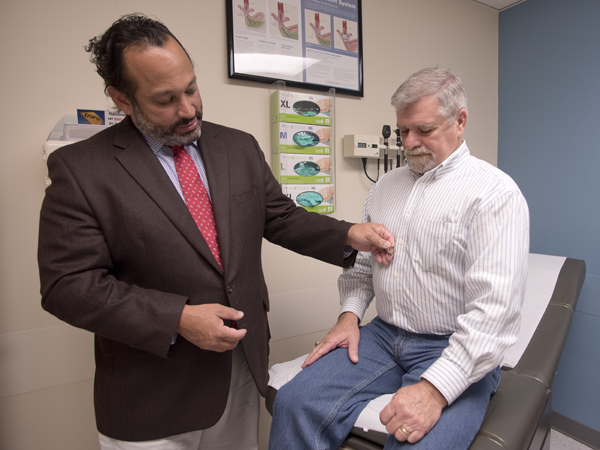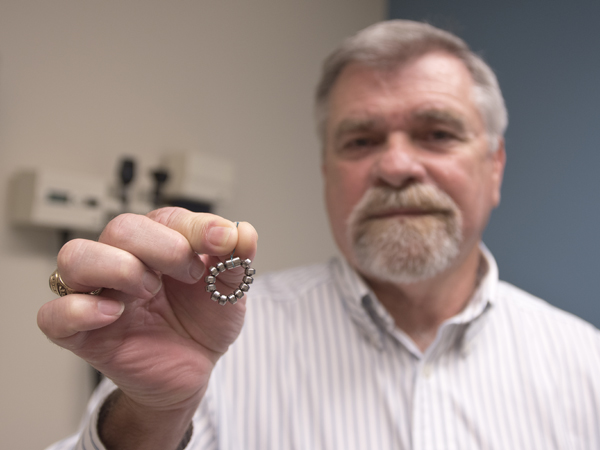Acid reflux procedure eases years of pain

Beginning when he was 27, life for the Rev. Earl Reyer was dictated by just how bad his acid reflux and spasms were that day.
“I lived in fear,” Reyer, a Bentonia resident who's now 61, said of pain caused by esophageal spasms so severe they're sometimes mistaken for a heart attack. “When you're a pastor, those short casket funerals are tough. You're standing there representing God, and all the time I'm dealing with stomach issues and reflux and hoping I don't have a spasm in the middle of a service.”
More than three decades and a plethora of medications later, Reyer took a leap of faith. He recently became one of the first patients at the University of Mississippi Medical Center to undergo a procedure using the LINX® reflux management system. It keeps stomach acids from traveling up the esophagus and causing gastroesophageal reflux disease, or GERD.
Generally referred to as reflux, GERD affects 20 percent of the population. It's caused by a weak muscle in the esophagus that allows stomach acid to enter the esophagus and cause chronic inflammation. GERD sufferers typically have burning pain in their chests and throat, trouble swallowing, and the feeling of food sticking rather than being properly swallowed.
The worst cases can put a patient at risk for esophageal cancer and chronic pulmonary disease. In Reyer's case, the ever-present acid also permanently damaged the enamel on his teeth, caused him to curtail travel, and left him sleeping upright in an easy chair. “Reflux took the joy out of my life,” he said. “It takes the icing off the cake.”
After undergoing back surgery last fall, Reyer just weeks later was treated for blood clots in his lungs. “I couldn't get my breathing back,” he said. “I went to the UMMC emergency room. They thought the reflux was affecting my air passages.”
He was referred to Dr. Pierre de Delva, an assistant professor of cardiothoracic surgery and a specialist in reflux and swallowing problems. De Delva told him about the options for treating GERD, Reyer said.
Reflux sometimes can be managed by lifelong medications, de Delva said, but severe cases can require surgery. The standard operation has been Nissen Fundoplication. That surgery can be done laparoscopically and involves wrapping the upper curve of the stomach around the esophagus. The lower portion of the esophagus passes through a tunnel of the stomach, creating a new barrier to reflux.
Only about 1 percent of GERD sufferers end up being referred for that procedure, de Delva said. “About 60 percent are well controlled on medication, but there's a gap of patients who aren't. Providers aren't ready to refer them for surgery because of the perception that the side effects of a Nissen aren't worth it, and because reflux isn't life threatening.”

Instead, de Delva implanted a LINX device in Reyer. Approved by the Federal Drug Administration in 2012, the LINX surgery is designed to target the gap population. It's done laparoscopically, and in Reyer's case, required a one-night hospital stay.
LINX is a series of titanium beads with magnetic cores connected together as a small bracelet with titanium wires. A surgeon implants the bracelet around the esophagus to increase the tone of the valve that normally prevents stomach acid from traveling up the esophagus.
The power of the magnetic beads keeps a weak or failed lower esophageal sphincter closed, but unlike a Nissen, the normal pressure generated by swallowing expands the magnets of the device and allows the sphincter to open. The ability of the LINX to expand results in fewer side effects, de Delva said.
Some patients post-surgery will experience some difficulty in swallowing, but it generally lasts only three or four weeks, de Delva said. “They have to work through that and push themselves to eat,” de Delva said. That was the case with Reyer.
Reyer's reflux “was particularly bad because it wasn't well controlled,” de Delva said. It was complicated by esophageal spasms, which Reyer said sometimes occurred every 45 seconds.
“You have to have an esophagus that can pump food through the (LINX) device,” de Delva said. “Some patients are not a candidate because of their anatomy, and might be better off with a Nissen. But if you have reflux that we can measure and document, LINX is appropriate.”
With patients who are good candidates for the procedure, “we try to do a lot of preparation on the front end,” said Gretchen Shull, a nurse practitioner who works with de Delva.
“With traditional acid reflux surgery, patients are on a liquid diet afterward. But you want to avoid that with the LINX,” she said. “We tell them that it requires some patience after the surgery, and that they need to eat small meals and drink liquids to push food down so that the magnets will open and close.”
Once the expected discomforts subside, Shull said, patients “get back to doing the things they were avoiding before surgery. For Mr. Reyer, it was a total game-changer.”
Two other hospital practices in Mississippi perform the procedure, de Delva said, and UMMC is the only program in the metro area. He's performed two so far at the Medical Center, one on Reyer and another on a female patient, and a number of other patients are being readied for the surgery.
“It's gone through a rigorous research process,” de Delva said of the procedure. “Five-year data shows about 90 percent of patients are satisfied, and it's designed to be just as good as the other procedure, but without the side effects” such as gas, bloating, the inability to vomit, and the feeling of food being stuck in the throat or chest.
“They hit it perfectly,” Reyer said of his procedure. “At 61, I think I might buy me another bass boat. I sold mine because I was nervous about getting a spasm while I was alone on the water.
“A lot of people you know aren't living. They're just waiting to die, and I was waiting to die. It's night and day now.”


